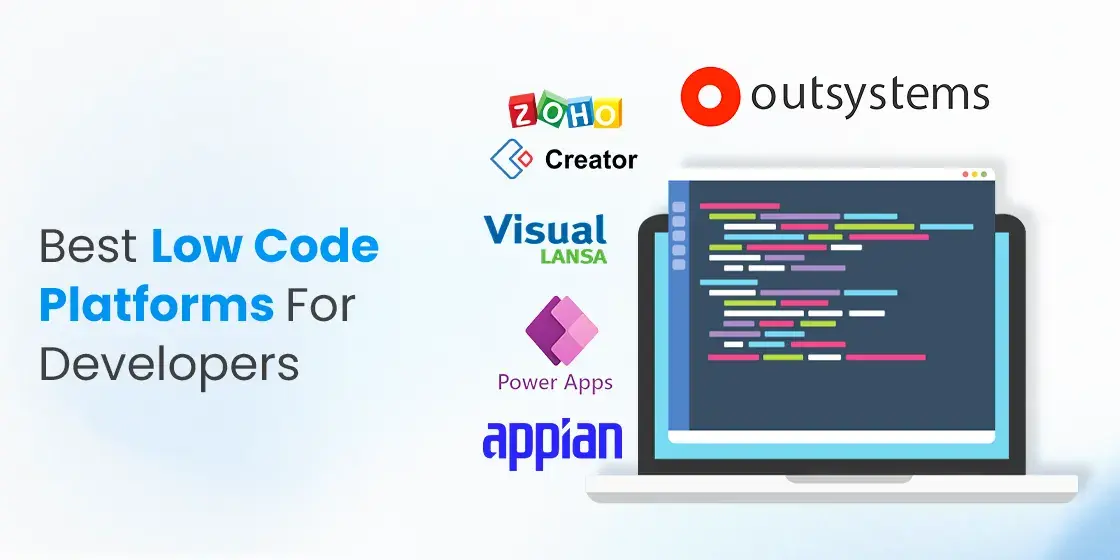Best Suggestions For Choosing Low-Code Platform Recommendations
Best Suggestions For Choosing Low-Code Platform Recommendations
Blog Article
Benefits Of Developing Applications Using Low-Code In Terms Of Speed
Visual Development Environment :
Drag-and-Drop Interfaces: Low-code platforms provide visual tools for designing applications. Developers can utilize drag-and-drop tools to create applications quickly and without having to write a lot of code.
Templates and pre-built components: Many low code platforms have pre-built components and templates that allow developers to quickly prototype and build applications.
Coding Requirements Reduced
Automated code generation: Low-code systems produce the underlying codes based on models that are visual and maintained by programmers. This reduces the need to code manually and improves the speed of development.
Reusable component: Developers are able to use the same components for various projects. This reduces time spent on developing code and testing.
Collaboration is streamlined:
Integrated Development Tools : Low code platforms typically include tools to test versions, deployment and version control. They facilitate collaboration among teams.
Citizen Development: Non-developers and business users can benefit from intuitive interfaces to contribute to the development of applications, which can reduce bottlenecks caused due to a shortage of professional developers.
Rapid prototyping and iteration:
Rapid prototyping: Designers can create quickly prototypes in order to gather feedback and validate concepts, which leads to faster iterations.
Easy Modifications: The visual nature of low-code development makes it easier to make updates and changes to applications. This speeds up the process of improving and refining applications based on user feedback.
Pre-built Integrations:
API Integrations: Low-code platforms are often pre-built with connectors for popular APIs and services. This cuts down on the time required to integrate external systems.
Data Integration: Built-in tools for data integration simplify the connection to databases and data sources. This accelerates development.
Deployment Scaling
One-Click Installation: A lot of low code platforms offer the option of installing with one click which reduces the amount of effort and time required to install applications.
Cloud-Based Solutions: Cloud-based, low-code platforms can manage infrastructure and scaling, allowing developers to focus on application logic and functionality instead of deployment logistics.
Overall, low-code development has the advantage in terms speed due to its capacity of automatizing and simplifying a variety of elements of development. This allows for quicker development of apps as well as easier adapting to the changing demands. Have a look at the best Low-code Platform for application development for more advice including cross platform mobile development, azure sql databases, cross platform mobile development, cross platform mobile development, app dev platform, developing mobile apps, ms azure sql, rapid action development, no code platforms, cross platform app dev and more.
Benefits Of Low-Code Application Development In Terms Of Flexibility And Scale
Low-code application development offers several advantages in terms of adaptability and scalability, which are crucial for building applications that are able to grow with business needs and adapt to changing requirements. Here are a few key benefits.
Cloud-based deployment: Many lowcode platforms are based on the cloud, which enables applications to scale with the infrastructure. Businesses can handle greater load without having to worry too much about the administration of servers.
Auto-Scaling Features: Built-in auto scaling features automatically adjust resources in accordance with the requirements. This allows for consistent performance even during peak times, without any manual intervention.
Flexible Architecture:
Modular Design: Low-code systems promote modular application design, where components can be independently developed test, scaled, and then redesigned. Modularity increases flexibility and allows for easier updates or expansions of specific parts without impacting the whole system.
Microservices Architecture: Microservices architecture allows the creation of applications using an loosely coupled collection of services. This increases both capacity and flexibility.
Customizable Solutions:
Extensibility: Low-code platforms typically permit custom programming and scripting, allowing developers to enhance the capabilities of the application beyond what is already available. This allows unique business requirements to be fulfilled without restrictions.
Third-Party Integrations: The ability to integrate with third-party services and APIs allows companies to add additional functions and services when needed, enhancing the application's capabilities.
Agile Development and deployment
Continuous Delivery and Deployment Low-code platforms can be used to implement agile methods which allow continuous integration as well as continuous delivery (CI/CD). This enables rapid deployment of features and updates. Applications are then able to grow rapidly in response to market changes and user feedback.
Iterative Development: The nature of low-code development implies that applications can be improved incrementally and scaled, reducing the risks of large-scale changes and permitting more controlled growth.
Resource Optimization
Effective Resource Management Low Code platforms optimize resource usage through tools that monitor and manage the performance of a program. This helps ensure that resources are used efficiently and are able to be scaled up or down based on the actual requirements.
Load-balancing: The program is able to handle large volumes of traffic efficiently and with a high degree of consistency due to the load-balancing functions.
Global Reach
Multi-Region deployment: Low-code applications can often support deployment across different geographical regions. This allows companies to offer low-latency to users from all over the world. This is crucial, particularly for applications with global users.
Localization Support: Built-in support for localization enables applications to easily adapt to various languages and regional needs and thereby allowing them to be more flexible in various markets.
Maintenance and updates:
Simplified maintenance: The visual and modular nature of low-code software makes it easy to perform the maintenance tasks. They allow upgrades and bug fixes to be made quickly without lengthy downtime.
Version Control System for Version Control: These integrated versions manage changes and rollbacks to ensure that updates are safe to be deployed and that previous versions can be restored if needed.
Cost Efficiency:
Low Development Costs. Through reducing the code requirements, low-code platform platforms cut down on the cost of development and enable applications to be scaled up without increasing development efforts.
Pay-as-you go models A lot of platforms for low-code users offer a variety of pricing options, including pay-as-you-go model that aligns costs and usage with the actual growth.
Low-code development provides businesses with a number of advantages, including scalability, flexibility, and flexibility. This allows them to create robust, adaptable and scalable applications. These platforms allow quick adjustments to the changing requirements, efficient resource usage, and continuous advancement. This means that the applications can evolve with the needs of the business. See the best he has a good point about Enterprise application development with Low-code Platform for website examples including build with docker, app modernisation, app dev platform, app dev platform, rad development, rad development, build a docker container, application development platforms, application modernisation, app modernisation and more.
Low-Code Apps Have Numerous Advantages When It Comes To Collaboration And Workflow
Low-code application development is a great choice for businesses who want to boost team productivity by streamlining the development process. Here are the major benefits: Improved Collaboration Across Functions:
Unified Development Environment : Low-code platforms offer a unified, single environment in which all team members are able to work effectively, including designers, business analysts, and stakeholders. This reduces the number of silos and enhances communication.
Visual Development Tools - The drag and drop visual nature of low code platforms allows non-technical personnel to take part in the process. This ensures that all business requirements are captured and implemented accurately.
Communication Improved:
Real-time collaboration: A lot of low code platforms provide real-time communication features like simultaneous editing and comments. Feedback is instantaneously available. This can help reduce the amount of time needed to exchange information back and forth.
Shared Workspaces Teams can work together using shared workspaces. These workspaces permit them to edit, view, discuss and collaborate on elements of the project.
A streamlined workflow management system:
Integrated Project Management Tools: Many low-code platforms have integrated tools for managing projects which can assist teams to track and manage their development projects. This includes the assigning of tasks, tracking progress, and managing deadlines.
Automation of routine workflows and activities reduces mistakes and manual labor, allowing teams and individuals to focus more on strategic initiatives and improve efficiency.
Speedier Iteration:
Rapid Prototyping : Low-code systems enable rapid prototyping. They also permit rapid and iterative development. This allows teams to develop, test and refine applications within shorter time frames. This allows feedback to be integrated quickly and improvements can be made.
Agile Development Support: Support of agile practices allows team members to develop sprints. They can continuously deliver small improvements in functionality and adapt more easily to changes in requirements.
Accessibility for Non-Developers
Citizens Development: Lowcode platforms enable users of business applications (citizen developers) to develop as well as modify and maintain applications without extensive code knowledge. This reduces the burden on IT teams and developers, allowing them to respond more quickly to business demands.
Training and Onboarding - Simple interfaces, comprehensive training resources and user-friendly interfaces make it simple for new team members to get up to speed and boost the overall team's cooperation.
Centralized Documentation, Knowledge Sharing, and Information Sharing
Documentation is integrated: Low-code platforms often come with tools to build and maintain documentation on the platform, making it easy for all project details to be centralized.
Knowledge Repositories : Teams can create knowledge repositories, which include templates, best practices, and reused components. This allows for sharing of knowledge and minimizes the need for duplicate efforts.
Consistency & Standardization
Standardized Components: The use standardized, pre-built components ensures uniformity across different applications, making it simpler for teams to comprehend and work on different parts of the project.
Governance and compliance Frameworks for governance and compliance that integrate help ensure that development conforms to organizational standards and regulatory requirements. This decreases the chance of noncompliance, and helps applications comply with quality standards.
Feedback loops:
Integrated Feedback Systems: Low code platforms offer integrated feedback systems that allow users to offer feedback about the application. The feedback can then be used in the development of those applications.
Continuous Improvement: The capacity for applications to iterate quickly and then implement changes in light of feedback, while ensuring they are in line to the needs of the user and business objectives.
Visualization & Reporting
Real-Time Analyses: The built-in reports and analytics tools give instantaneous insight into the project's progress, performance and user interactions, which allows for data-driven decisions.
Visual Workflow Mapping Visual tools for mapping workflows and processes helps teams comprehend and optimize their workflows by identifying gaps and areas to improve.
For collaboration, low-code apps are ideal for reducing workflows, bring diverse teams together and automate tasks. This encourages a collaborative environment that is agile and efficient in its development process, resulting in more high-quality apps as well as a better alignment between business goals.